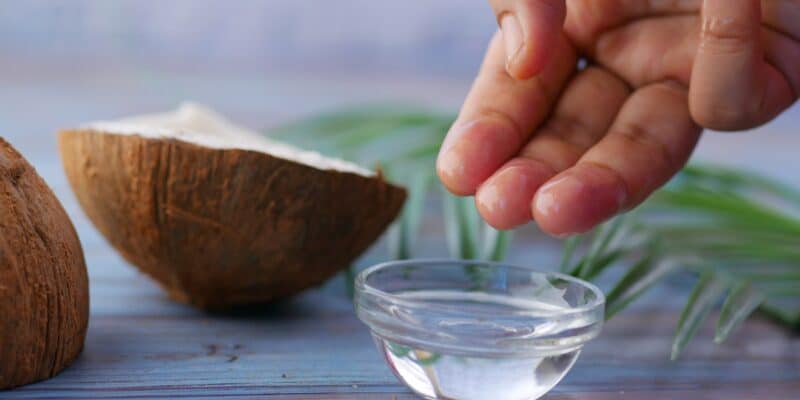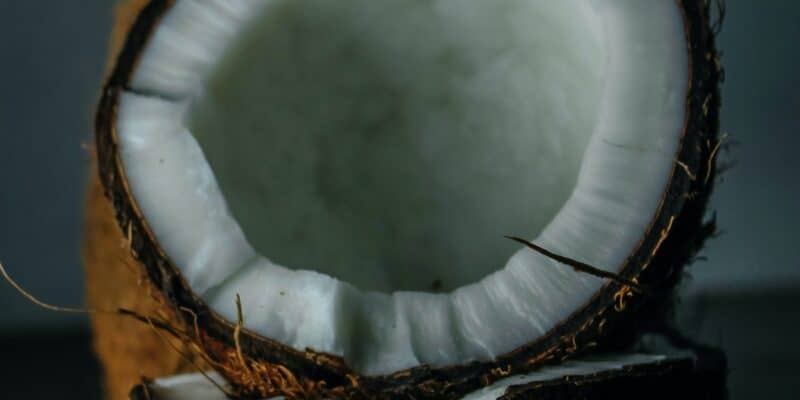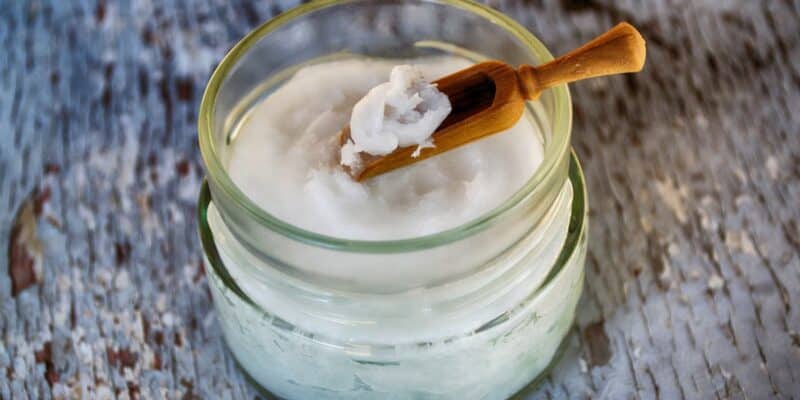In recent years, coconut oil has become hugely popular. Not only does it have an abundance of health benefits, supposedly including arthritis relief, it’s great as a beauty product too.
Many influencers are seen applying coconut oil to their skin, hair, or using it as a makeup remover. Some even claim it’s an effective deodorizer as it contains antibacterial properties.
According to an article in the New York Times 2016, a survey found that 72% of Americans rated coconut oil as “healthy,” though only 37% of nutrition experts agreed.
Nevertheless, the coconut oil craze continues, it makes a fantastic cooking or baking oil with a great aromatic flavor. Saturated fat makes up nearly 90% of coconut oil (according to Medical News Today).
The high fat content may be great when preparing your dinner, but it means coconut oil is a thicker oil in comparison to other oils. This is the exact reason why you want to avoid this oil spilling onto your clothes!
As an Amazon Associate, I earn from qualifying purchases. The links below may be affiliate links. Please read my disclosure policy for more information.
Will Coconut Oil Stain my Clothes?

Good news is, coconut oil shouldn’t stain your clothes, but of course it may still cause some staining if left untreated. If cleaned quickly you’re more likely to avoid any damage to your clothing.
But sometimes we don’t even notice the oil spill until later, so then what? At this stage your clothes may have developed a dark stain.
Staining ultimately depends on how long the oil has been left on the fabric. So it’s better to act quickly!
Removing coconut oil as soon as possible from your clothing isn’t tricky at all, most of the items you need will already be in the home.
It just Happened! How to Remove a New Spill?
New spills are much easier to get clean. Follow the simple steps below to see fast results:
Option 1 – Dishwashing Liquid
- Blot off excess oil with a clean cloth or paper towel
- Mix a little dishwashing liquid with water and rub generously into the spill – place a clean dry cloth under the fabric to avoid this leaking through to another part of the garment
- For stubborn spills, leave the dishwashing liquid on the garment for 5 minutes
- Place your garment into the washing machine on the hottest cycle recommended for your clothing. You can use your regular detergent and add alongside your regular laundry – it must not be a cold cycle as the high fat content will not dissolve
- Dry your garment as you usually do
Option 2 – Baking Soda or various powders
- Blot off excess oil with a clean cloth or paper towel
- Liberally cover your spill with cornstarch, baking soda, arrowroot powder or baby powder (avoid baking soda if it’s a delicate fabric)
- Leave the powder to sit on the spill for 15 minutes – you’ll notice the powder will turn a yellowish brown when it begins to absorb the oil
- Add more powder if it turns yellow/brown very quickly, as you will need more to soak the remaining oil
- Repeat this process until the oils have all been removed
- Scrape off the powder carefully using a kitchen scraping tool, or a credit/store card
- Place your garment into the washing machine on the hottest cycle recommended for your clothing. You can use your regular detergent and add alongside your regular laundry – it must not be a cold cycle as the high fat content will not dissolve
- Dry your garment as you usually do
Option 3 – If in doubt, do both of the above!
- Blot off excess oil with a clean cloth or paper towel
- Liberally cover your spill with cornstarch, baking soda, arrowroot powder or baby powder (avoid baking soda if it’s a delicate fabric)
- Leave the powder to sit on the spill for 15 minutes – you will notice the powder will turn a yellowish brown when it begins to absorb the oil
- Add more powder if it turns yellow/brown very quickly, as you will need more to soak the remaining oil
- Scrape off the powder carefully using a kitchen scraping tool, or a credit/store card
- Mix a little dishwashing liquid with water and rub generously into the spill – place a clean dry cloth under the fabric to avoid this leaking through to another part of the garment
- For stubborn spills, leave the dishwashing liquid on the garment for 5 minutes
- Place your garment into the washing machine on the hottest cycle recommended for your clothing. You can use your regular detergent and add alongside your regular laundry – it must not be a cold cycle as the high fat content will not dissolve
- Dry your garment as you usually do
Does the Type of Fabric Affect the Outcome?

Clothing comes in all sorts of various fabrics. As you can imagine, the amount of oil absorbed depends on the type of fabric.
100% cotton absorbs the most oil. Polyester still absorbs oil, but not quite as quickly as cotton.
However, once polyester has absorbed oil, its much trickier to remove. Let’s look at specific cleaning methods for different fabrics:
White or Light Colored Cotton
Baking soda and detergent are safe options for these colors. There’s little worry that the cleaners will remove any coloring.
Cotton holds up well to a little scrubbing and the fabric wont easily ruin. Running a very hot cycle will also prove effective for white or light cotton.
Dark or Brightly Colored Cotton
There’s a high risk of baking soda stripping color from your dark or bright cotton garment. Hot water can also be harsh on these colors and potentially cause fading.
To avoid this, replace baking soda with cornstarch. Apply the paste to the stain and leave to soak for 15 minutes.
Wash on a cold cycle with your usual detergent or a little dishwashing liquid.
Polyester
Polyester holds up well to baking soda, so go ahead and soak up the oil for a few minutes. You may need to repeat this process as polyester stains can be trickier to remove.
Use dishwashing liquid to rub away at the stain. Lastly avoid hot water cycles, this will ruin your fabric; wash in a cold water cycle using your usual detergent.
Alternatively, stretch the stained area after treating, and gently pour some hot water over the stain, finally wash in a cold cycle.

Silk and Delicates
To avoid causing holes in your delicate clothing, avoid scrubbing or rubbing harshly. Swap baking soda with baby powder for a less abrasive clean.
Allow the powder to sit on the stain for 1 hour before using your finger to rub the powder. Wash in your usual delicate cycle, or by hand.
Finish by air-drying to make sure the stain has been completely removed.
How to Dry my Clothes?
Once your clothes are treated and washed, it’s very important to check on that stain. Fabric with oil stains which have successfully been removed, are safe to go in the tumble dryer.
However, if there is any remaining oil, drying in a tumble dryer with the extra heat will only strengthen the stubborn stain. Make sure you repeat the cleaning process to remove any residue before you proceed to dry.
If you are unsure whether the stain has been completely removed, air-dry your fabric before checking on the stained area.
Removing an Aged Stubborn Coconut Oil Stain
It’s not uncommon that we don’t notice a stain until it’s come out of the wash and dried. An old stain may be hard to remove but it can still be possible.
This method is for cotton fabric only:
- Place a light towel or a piece of card under the stained fabric
- Spray a little WD-40 onto a paper towel or cotton ball and carefully dab onto the stain
- Top the stain with some baking soda or cornstarch and brush with a soft brush, inwards
- Leave the powder to soak up the oil for a few minutes, the powder will begin to clump
- Scrape off the powder
- Repeat this process until the powder remains powdery
- Clean the area with dishwashing liquid, and leave for 30 minutes before laundering as usual
Are there any alternative methods?
Yes absolutely! There’s never one rule for anything.
You may find your store cupboard is empty of baking soda and you no longer keep a tub of baby powder as your teen is a little too big for that now! Check the list below and see what works well for you:
Toothpaste
Use a non-gel white toothpaste. Squeeze a little onto the stain and using a soft toothbrush rub the area in circular motions.
Rubbing Alcohol & Bar Soap
Use a cotton ball to dab some rubbing alcohol onto your stain. Rub the stained area with the bar soap.
White Distilled Vinegar
Soak your garment for 1-2 hours in equal quantities of vinegar and cold water. Remove from the solution and drain.
Using baking soda (or any alternative powder mentioned above) and coat the stain. Leave for 10 minutes then clean using dishwashing liquid.
Whichever alternative method you use, finish by laundering as usual.



![WD-40 Original Formula, Multi-Use Product with Smart Straw Sprays 2 Ways,12 OZ [12-Pack]](https://m.media-amazon.com/images/I/512uw0hjm8L.jpg)

